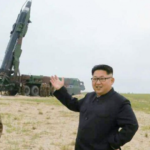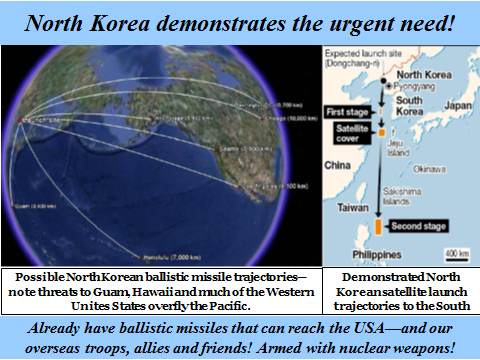“To jaw-jaw is always better than to war-war.” ~Sir Winston Churchill
It is entirely appropriate to refer to Churchill’s famous claim when considering President Trump’s pending discussions with Kim Jong Un in Hanoi, which are the focus of much attention around the world — including a debate over what might be the possibilities.
Moreover, as one who spent ten years preparing for and engaging in negotiations with the Soviet Union, I understand that negotiations can lead to positive results that go far beyond what might first have been considered to be possible.
For example, few believed in the 1970s that the Soviets would ever agree to very intrusive inspection procedures; and so we spent many hours trying to figure out how to verify arms control agreements with “National Technical Means” (NTM) alone.
But the Reagan administration recognized the failures of such NTM verification methods — along with recognized repeated Soviet violations — and pursued agreements including intrusive inspection methods, in our negotiations with the Soviets. And our negotiators were successful.
Regrettably, later negotiators relaxed some demands of that era, and our leaders abandoned key objectives of Reagan’s Strategic Defense Initiative (SDI) — like building space-based interceptors to intercept ballistic missiles in their “boost-phase,” while their rockets still burn and before they can release multiple warheads and associated penetration aids. This SDI capability had helped our negotiators achieve a ban of large ballistic missiles that carried many nuclear warheads.
Surprise! After the Clinton administration killed this key SDI effort in early 1993 — and after the arrival of Russian President Vladimir Putin and his explicitly stated interest in restoring former Soviet conditions, the Russians again emphasized building large intercontinental-range ballistic missiles (ICBMs) that can carry multiple warheads. And they now are claiming to have “hypersonic” missiles that can defeat our currently deployed and less capable ballistic missile defense systems.
So, insisting on worthy goals can lead to positive results, if we demand they be met . . . and those achievements can be lost if we do not persist with key supportive actions.
So . . . What to expect from President Trump’s negotiations with Kim?
Consider where we were a year ago.
Much was made about a trip to Pyongyang by then CIA Director and now Secretary of State Mike Pompeo, to help set the stage for the first Trump-Kim meeting in Singapore. The benefits of that meeting were disputed, and there continues a political divide in Washington among those considering many initiatives sought by the Trump administration.
That continues to be the case in anticipation of the Hanoi meetings that begin tomorrow — and we hope for the best.
But “hope is not a strategy,” and these and other hopeful aspirations are very complicated. A positive outcome of the pending negotiations has been and will be impeded by a quarter century of failed attempts to block North Korea’s programs to produce a now demonstrated nuclear and ballistic missile capability, clearly demonstrated over a year ago.
Positive outcomes are certainly possible, but it seems to me that negotiations are unlikely to achieve anytime soon a demilitarized North Korean peninsula as many have hoped.
A year ago, Kim Jong Un stated he had the nuclear weapons and the missiles he needed to deliver them. In my view, his claim was and remains valid — and our negotiators must take it into account as we pursue our objectives, which I believe should include building our missile defenses in view of that reality.
Much has been made of the fact that our Intelliigence Community leaders recently testified that North Korea will seek to retain that capability. It’s hard to imagine them saying anything else, given that two years ago our intelligence community acknowledged North Korea then could have 60 nuclear weapons — and, prior to the Trump-Kim meeting in Singapore, had tested ballistic missiles that could reach Guam (a U.S. territory), Hawaii, Alaska, and the entire continental United States.
Some take heart from the fact that many of North Korea’s underground tests have involved only low yield nuclear explosions — they assume these tests were failures because they think North Korea needs large yield nuclear weapons to threaten us. But large yield nuclear weapons are not needed to produce the existential threat of an electromagnetic pulse (EMP) attack — and Russian Generals told the EMP Commissioners a decade ago that Russia had “accidentally” passed to North Korea how to build low-yield “super EMP” weapons.
Others, including senior officials who ought to know better, claim that North Korea still must prove they have the technology to reenter the Earth’s atmosphere with sufficient accuracy to hit an American city. But an existential threat from an EMP attack requires neither high accuracy nor to reenter the earth atmosphere. North Korea could detonate a nuclear weapon in space — e.g., almost anywhere over the eastern half of the United States, which would shut a major portion of the electric power grid that serves most Americans.
Above is a chart from one of my briefings given repeatedly over the last couple of years, illustrating possible ballistic missile trajectories from North Korea on the left — and on the right the trajectory of North Korea’s launch of its space satellites toward the south. Note that many of these trajectories could be intercepted by our 44 ground-based interceptors in Alaska and California. But North Korea could overwhelm those defenses with a larger number of attacking ballistic missiles, which it may have.
We should take seriously North Korea’s explicit claim two years ago that achieving an EMP attack capability was a “strategic goal,” especially when considering the threat of nuclear weapons launched southward, whether from North Korea’s mobile ballistic missiles launchers — or from its satellite launch site illustrated above. And we should be supplementing our ballistic missile defense (BMD) systems to counter this threats.
We have had several opportunities for such supplements that deserved high priority. For example, click here and here for my 2017 and 2018 Newsmax articles arguing that we should quickly adapt U.S. aircraft to intercept ballistic missiles early shortly they are launched to counter this then existing threat. And click here for my April 20, 2018 Newsmax article noting that our negotiations with North Korea also could be quickly supported by enabling our (and Japan’s) Aegis BMD cruisers and destroyers near North Korea to provide such needed defenses.
Such initiatives could and hopefully will back up President Trump’s “Peace through Strength” approach to national security, especially in his negotiations to denuclearize North Korea. Just as the Strategic Defense Initiative (SDI) gave enormous leverage to President Reagan’s negotiations with the Soviet Union, advancing our missile defense capabilities can advance our negotiations with North Korea. The President’s Space Force Initiative and related programs can be very helpful as well.
But we should not forget the continuing threat from North Korea — especially from an EMP attack. Click here for an early discussion of North Korea’s initiative, in which Kim Jong Un is quoted as saying North Korea’s achievement was a “great victory,” so “no nuclear test and intermediate-range and inter-continental ballistic rocket test-fire are necessary . . . now.“
As implied above, I believe this claim is still most likely true.
These conditions remind me of the second half of the 1980s, when I was privileged to lead the Defense and Space Talks with the Soviet Union and protected President Reagan’s SDI program against efforts to scuttle it.
Our opposition came from not only the Soviets but also from many in the international community as well as in the United States. Happily, we prevailed and can today provide at least limited defenses against missile attacks, though the Clinton administration cancelled the most important SDI products as I have discussed before.
But the SDI program that was demonstrating President Reagan’s vision of building effective BMD systems, and his insistence that SDI was not negotiable, gave our overall Nuclear and Space Talks (NST) negotiations considerable leverage.
He walked out of the Reykjavik Summit in October 1986 because of Gorbachev’s demand that he restrict our space based defense demonstrations to the laboratory. This highly visible step made his commitment clear, while he pocketed Soviet concessions in our negotiations on offensive nuclear forces.
In conjunction with his Strategic Modernization Program that repaired the impact of many years of neglect of our strategic systems, his thus demonstrated condition led to the first arms control treaties ever to reduce significantly the world’s nuclear weapons. Notably, Britain’s Prime Minister Margaret Thatcher claimed, “SDI ended the Cold War without firing a shot.”
Bottom Lines.
To be sure, Winston Churchill was correct in stating “To jaw-jaw is always better than to war-war.” But successful negotiations to achieve agreements supporting U.S. national security interests must be backed up with persistent conditions.
President Trump — like President Reagan — has laid down some clear markers for concluding any significant agreement with North Korea. For example before last year’s Singapore Summit , he noted that if that meeting was not fruitful, he would “respectfully leave the meeting.” I hope he holds firmly to this very important condition in Hanoi.
And it is also very important that he hold firmly to his separate Space Force objective and related initiatives to build truly effective space-based defenses. Click here for a discussion of the important related question: Will the Pentagon follow through on President Trump’s Space Force?
Indeed, stay the course, Mr. President!
What can you do?
Join us in praying for our nation, and for a rebirth of the freedom sought, achieved and passed to us by those who came before us.
Help us to spread our message to the grass roots and to encourage all “powers that be” to provide for the common defense as they are sworn to do.
Begin by passing this message to your friends and suggest they visit our webpage www.highfrontier.org, for more information. Also, please encourage your sphere of influence to sign up for our weekly e-newsletter.
Encourage them to review our past email messages, posted on www.highfrontier.org, to learn about many details related to the existential manmade and natural EMP threats and how we can protect America against them. I hope you will help us with our urgently needed efforts, which I will be discussing in future messages.
Click here to make a tax deductible gift. If you prefer to mail a check, Please send it to 500 North Washington Street, Alexandria, VA 22314.
E-Mail Message 190226
Please click here to read Past Weekly Updates!
Please help High Frontier continue this important and timely work!
Be sure to follow us on our Social Sites!
If you found this letter via our Social Sites, and you would like to subscribe, please click below!






